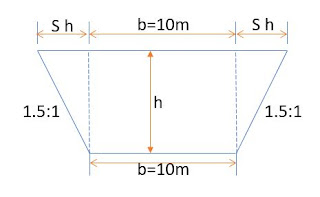Computation of Volume
· In
many civil engineering projects, earth work involve the excavation, removal and
dumping of earth, therefore it is required to make good estimate of volume of
earth work.
· Volume
computation are also required to determine the capacity of reservoirs.
· The
volume of the earth work is calculated by
I.
The Trapezoidal rule
II.
The Prisimoidal Rule.
Example:
An
embankment of width 10m and side slope 1.5:1 is required to be made on a ground
which is level in a direction traverse to centre line . The central height at
20m intervals are as follows 08,1.2,2.25,2.6,1.9,1.4 and 0.9
Calculate
the volume of earth work according to
I.
The trapezoidal rule
II.
The Prisimoidal rule
Solution:
Here
b=10m, S=1.5, interval=20m
The
cross-sectional area is calculated by equation
Area=
(b+sh) h
Δ1=(10+1.5 x0.8)0.8=8.96m2
Δ2= (10+1.5 x1.2)1.2=14.16m2
Δ3=(10+1.5 x2.25)2.25=30.09m2
Δ4=(10+1.5 x2.6)2.6=36.14m2
Δ5=(10+1.5 x1.9)1.9=24.42m2
Δ6=(10+1.5 x1.4)1.4=16.94m2
Δ7=(10+1.5 x0.9)0.9=10.22m2
Volume
From Spot Levels:
· In
this method, the field work consists in dividing the area in to a number of squares,
rectangles (or) triangles and measuring the levels of their corners before and
after the construction.
· Thus
the depth of excavation (or) height of filling at every corner is known
· Let
us assume that the four corners of any one square (or) rectangle are at
different elevations but lie in the same inclined plane.
· The
rectangle abcd represents the horizontal projection of the upper inclined base
of the prism and also the lower horizontal base.
· Let
us consider the rectangle abcd, ha, hb, hc , and hd represent the depth of
excavation of the four corners , the volume of the right truncated prism will
be given by








Comments
Post a Comment